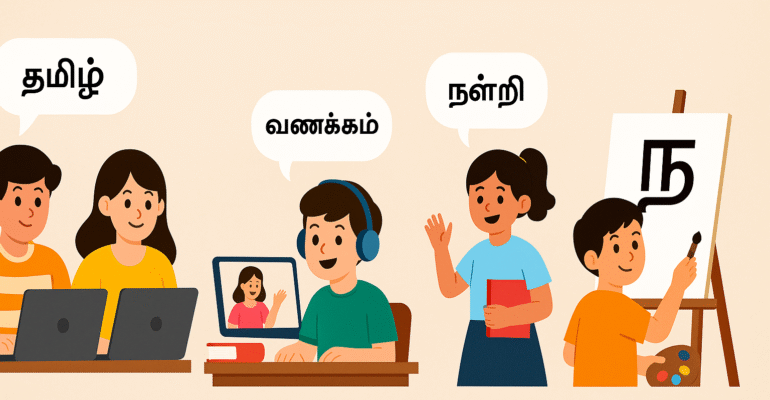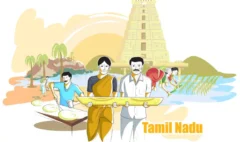The Best Tamil Documentaries to Learn From
The Best Tamil Documentaries to Learn From
Beyond Fiction: A Guide to the Best Tamil Documentaries for Language Learners
In our quest to learn Tamil, we often turn to the vibrant world of cinema, with its captivating stories and memorable songs. While feature films are a fantastic resource for learning conversational language, there is another, often overlooked, genre of filmmaking that can offer a deeper, more factual, and incredibly enriching learning experience: the documentary. Tamil documentaries (ஆவணப்படங்கள் – aavanappadangal) provide a unique and powerful window into the reality of the Tamil-speaking world. They are a treasure trove of specialized vocabulary, clear narration, and profound cultural insights. For the intermediate to advanced learner, learning Tamil with documentaries is a way to move beyond everyday conversations and engage with the language of history, science, society, and art. This guide will introduce you to the value of documentaries as a learning tool and highlight some of the best educational Tamil videos and cultural documentaries that can elevate your language skills and deepen your understanding of the culture in a way that fiction rarely can.
Why Documentaries are a Goldmine for Language Learners
Documentaries offer a unique set of benefits that make them a particularly effective tool for language acquisition, especially for learners who have moved beyond the beginner stage.
- Clear, Formal Narration: Unlike the fast-paced, slang-filled dialogue of many feature films, documentaries often feature a narrator who speaks in clear, well-enunciated, and grammatically correct formal Tamil. This is the perfect “bridge” between the textbook language you have learned and the fast-paced spoken language of the street. The narration provides a clean and clear model of the language that is excellent for your listening comprehension.
- Specialized Vocabulary in Context: Documentaries are, by their nature, focused on a specific topic. A documentary about a historical monument will be filled with vocabulary related to history, architecture, and royalty. A film about a social issue will introduce you to the language of sociology and current events. This thematic approach is an incredibly effective way to learn a whole set of related vocabulary in a rich and meaningful context.
- Visual Support for Complex Ideas: Documentaries are designed to explain complex topics. They use a combination of interviews, archival footage, graphics, and real-world visuals to support the narration. This visual context is a huge aid to comprehension. Even if you don’t understand every word of the narration, the images on the screen will help you to follow the story and understand the main ideas.
- Deep Cultural and Historical Immersion: Documentaries take you directly into the heart of the culture. They allow you to hear the voices of real people—artisans, farmers, historians, activists—telling their own stories in their own words. This is a level of authenticity and cultural immersion that is difficult to find elsewhere.
How to Learn Actively with Documentaries
To get the most out of watching a documentary, you need to be an active viewer.
- Choose a Topic That Genuinely Interests You: Your motivation will be much higher if you are watching a film about a subject you are passionate about, whether it’s temple architecture, wildlife, or social history.
- Use the “Three-Viewing” Method:
- First Viewing (with English subtitles): Watch the documentary once with English subtitles to understand the topic, the main arguments, and the overall narrative. This gives you the context you need for the real learning to begin.
- Second Viewing (with Tamil subtitles, if available): Watch it again, this time with Tamil subtitles. Pause frequently. When you encounter a new or important word, write it down in your vocabulary notebook along with the sentence it was used in. This is your deep-dive study session.
- Third Viewing (with no subtitles): After a day or two, watch it one last time with no subtitles. You will be amazed at how much more you can understand. This final viewing helps to consolidate what you have learned.
- Focus on the Interviews: Pay close attention to the interview segments. This is where you will hear the language as it is spoken by a variety of real people, with different accents and speaking styles. It’s a fantastic real-world listening exercise.
Recommended Tamil Documentaries for Learners
Finding Tamil documentaries with good subtitles can sometimes be a challenge, but the landscape is improving. Here are a few notable examples and types of documentaries to look for on platforms like YouTube, Netflix, and Amazon Prime Video.
1. For the History Buff: “The Great Chola Temples” and Historical Series
There are numerous documentaries produced by Indian television channels (like DD Podhigai) and independent filmmakers about the great historical monuments of Tamil Nadu.
- What you’ll learn: These films are a goldmine of historical and architectural vocabulary. You will learn words like “பேரரசு” (perarasu – empire), “மன்னன்” (mannan – king), “சிற்பம்” (sirpam – sculpture), “கோபுரம்” (gopuram – temple tower), and “கல்வெட்டு” (kalvettu – stone inscription). The narration is almost always in a very clear, formal Tamil, making it excellent for intermediate learners.
* Where to look: Search on YouTube for terms like “தஞ்சை பெரிய கோவில் ஆவணப்படம்” (Thanjai Periya Kovil aavanappadam – Big Temple documentary) or “மாமல்லபுரம் ஆவணப்படம்” (Mamallapuram aavanappadam).
2. For the Nature Lover: Wildlife and Environmental Documentaries
Documentaries about the unique ecosystems of Tamil Nadu, such as the Western Ghats or the Gulf of Mannar, are both visually stunning and linguistically rich.
- What you’ll learn: These films will teach you the Tamil names for plants (தாவரங்கள்), animals (விலங்குகள்), and birds (பறவைகள்), as well as important environmental terms like “சூழல்” (soozhal – environment) and “பாதுகாப்பு” (paadhukaappu – conservation).
* Example: The recent and critically acclaimed documentary “The Elephant Whisperers” (ஆஸ்கார் விருது வென்ற ஆவணப்படம்), while primarily featuring conversational Tamil, is a beautiful and accessible film that offers a powerful emotional story and a great deal of nature-related vocabulary. Even if the original audio has English, watching the dubbed Tamil version is a fantastic learning experience.
3. For the Socially Conscious: Documentaries on Social Issues and Biographies
Tamil filmmakers have a strong tradition of producing powerful documentaries that explore the social and political fabric of the state.
- What you’ll learn: These films will expose you to the language of social justice, politics, and the everyday lives of different communities. They are excellent for advanced learners who want to understand the complex contemporary issues of the region.
* Where to look: Look for biographies of major figures like political leaders or social reformers. Search for documentaries on specific social movements or historical events. These are often produced by independent filmmakers and can be found on YouTube or Vimeo.
4. For the Foodie: Culinary and Travel Documentaries
Travel and food shows are a fun and engaging way to learn. They combine beautiful visuals with practical, everyday vocabulary.
- What you’ll learn: You will learn the names of different dishes, ingredients, and cooking techniques. You will also hear the language as it is spoken in the streets, markets, and restaurants of different regions, giving you a wonderful feel for local dialects.
* Where to look: Search for “தமிழ்நாட்டு சமையல்” (Tamil Nadu samaiyal – Tamil Nadu cooking) or travel shows that explore different cities in the state. Many Tamil television channels have their food and travel shows available on YouTube.
Conclusion: A Window to Reality
While the fantasy worlds of cinema are a wonderful escape, the real worlds presented in documentaries offer a different, and in many ways, a deeper kind of learning. They provide a direct, unfiltered connection to the history, the nature, the society, and the people of the Tamil-speaking world. By incorporating Tamil documentaries into your learning routine, you are making a commitment to understanding the language in its fullest context. You are moving beyond the script of a film and into the script of real life. This will not only make you a more proficient speaker of Tamil, but a more knowledgeable, empathetic, and informed student of the rich and complex culture it represents.










